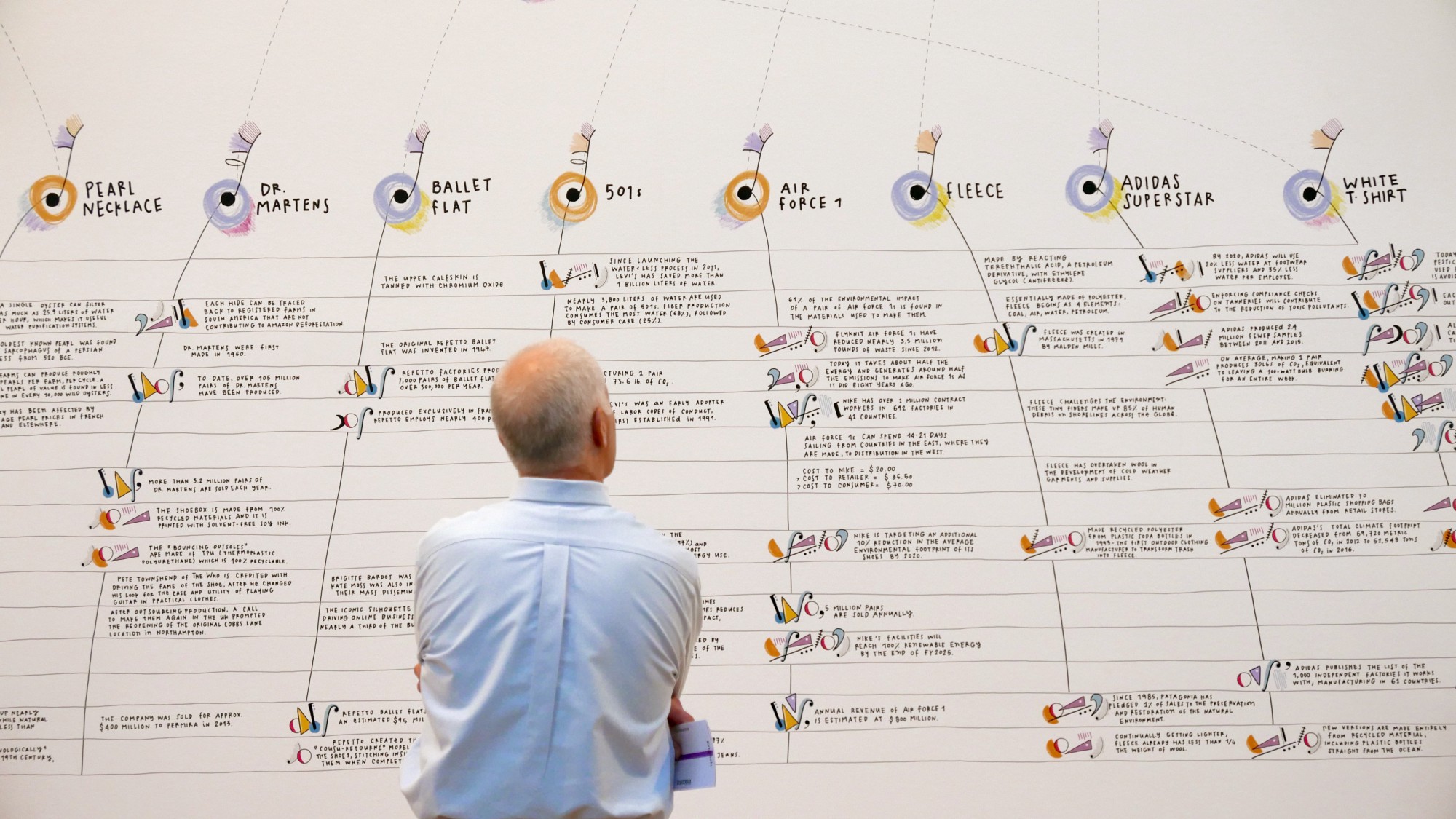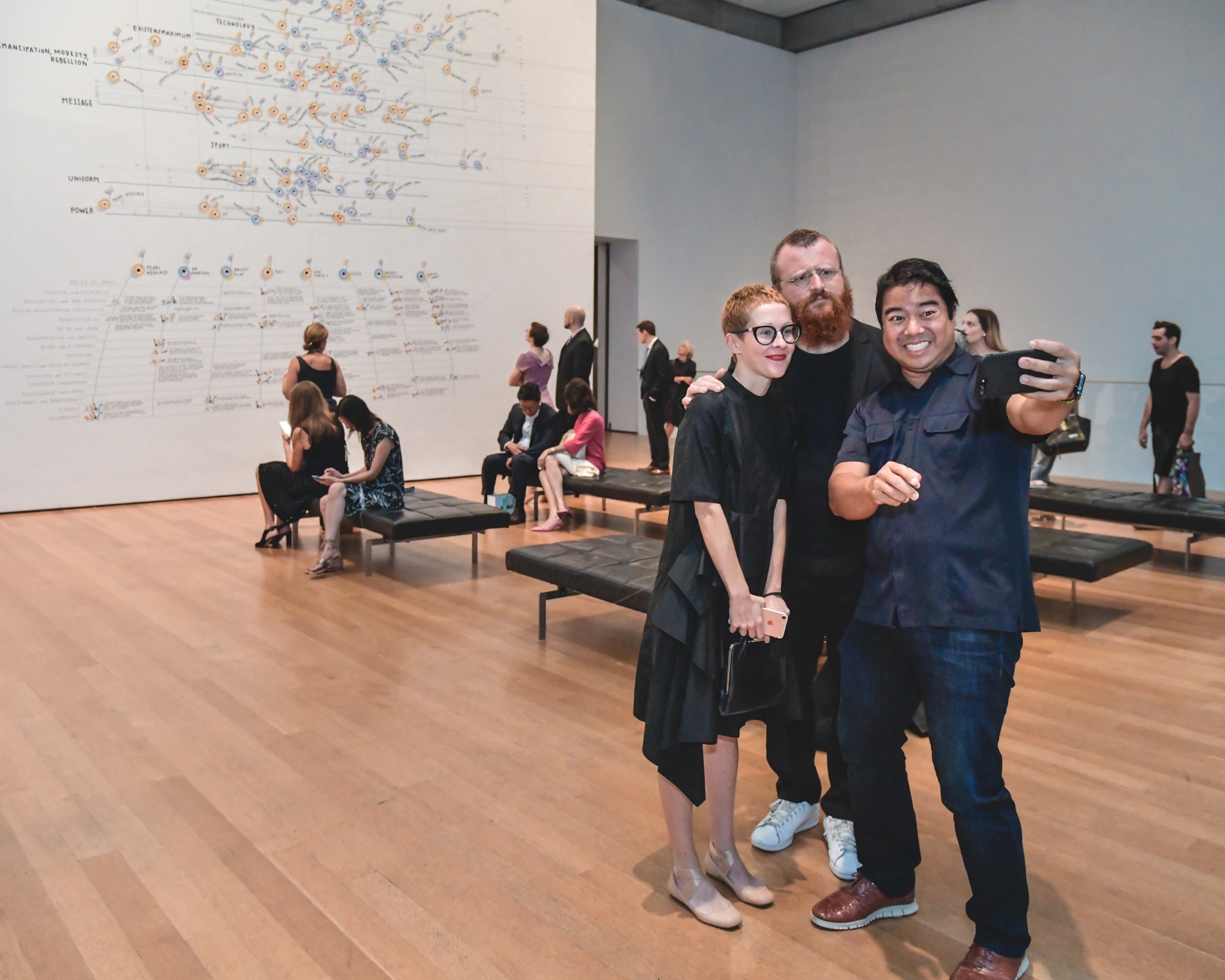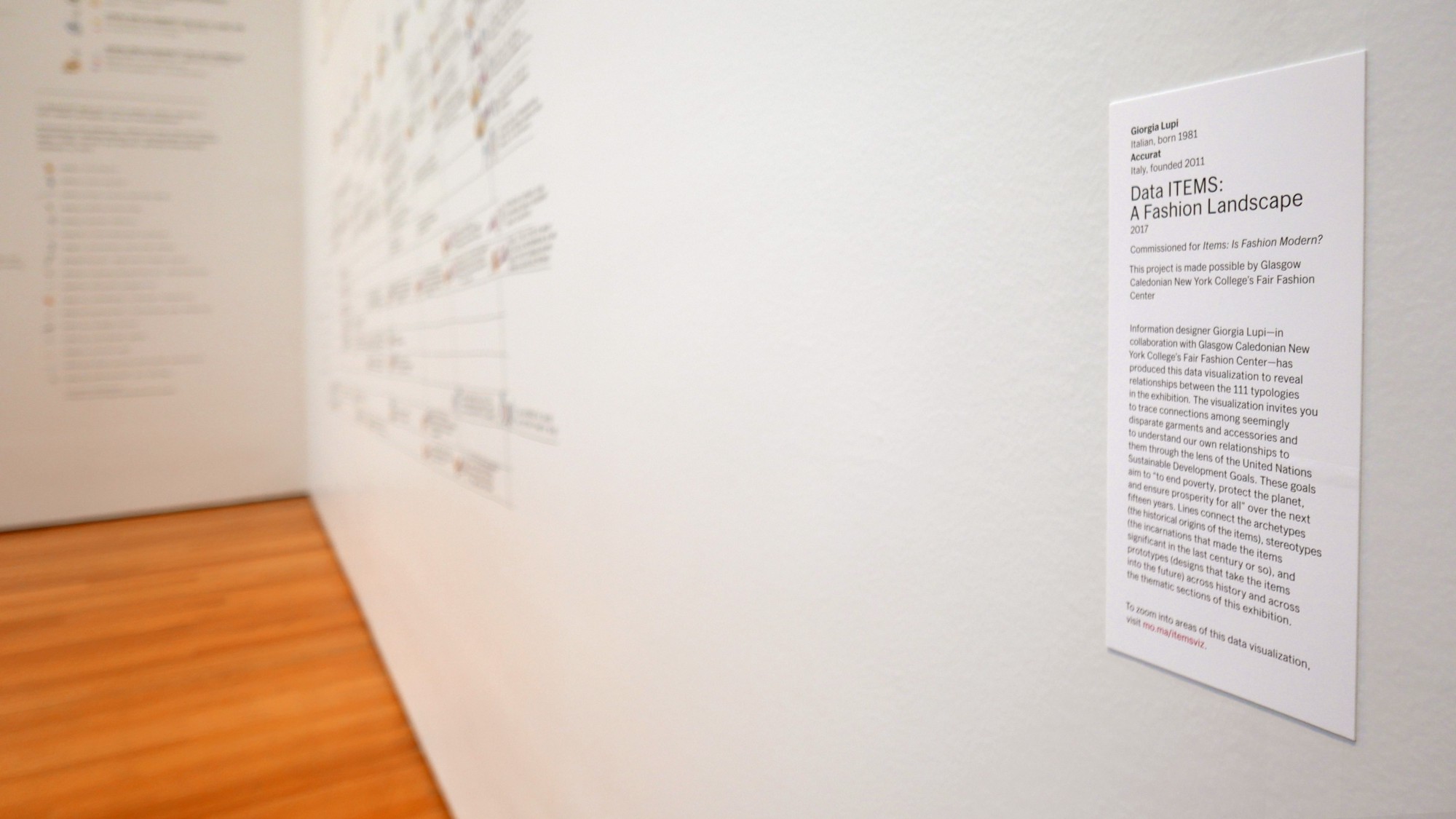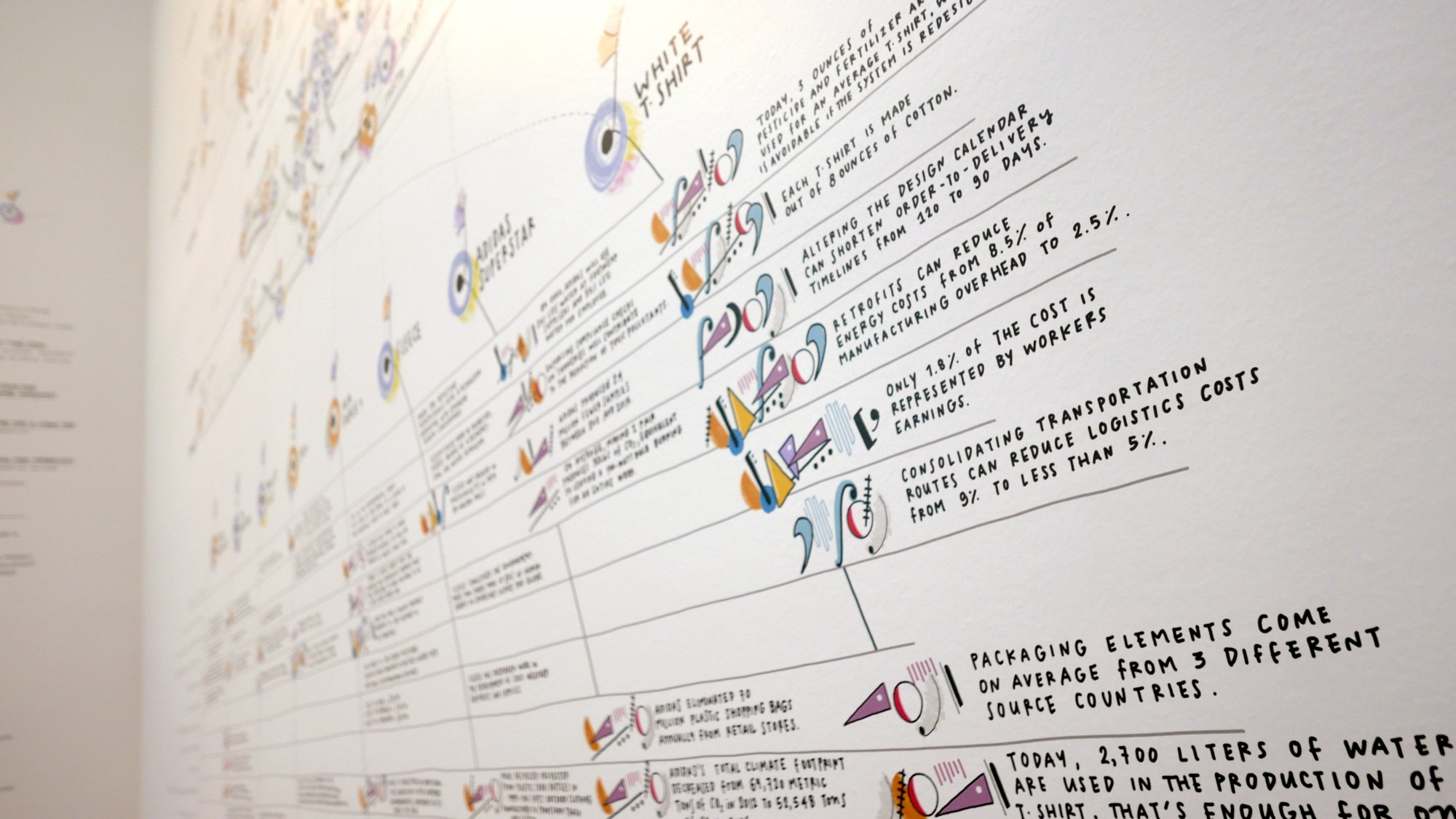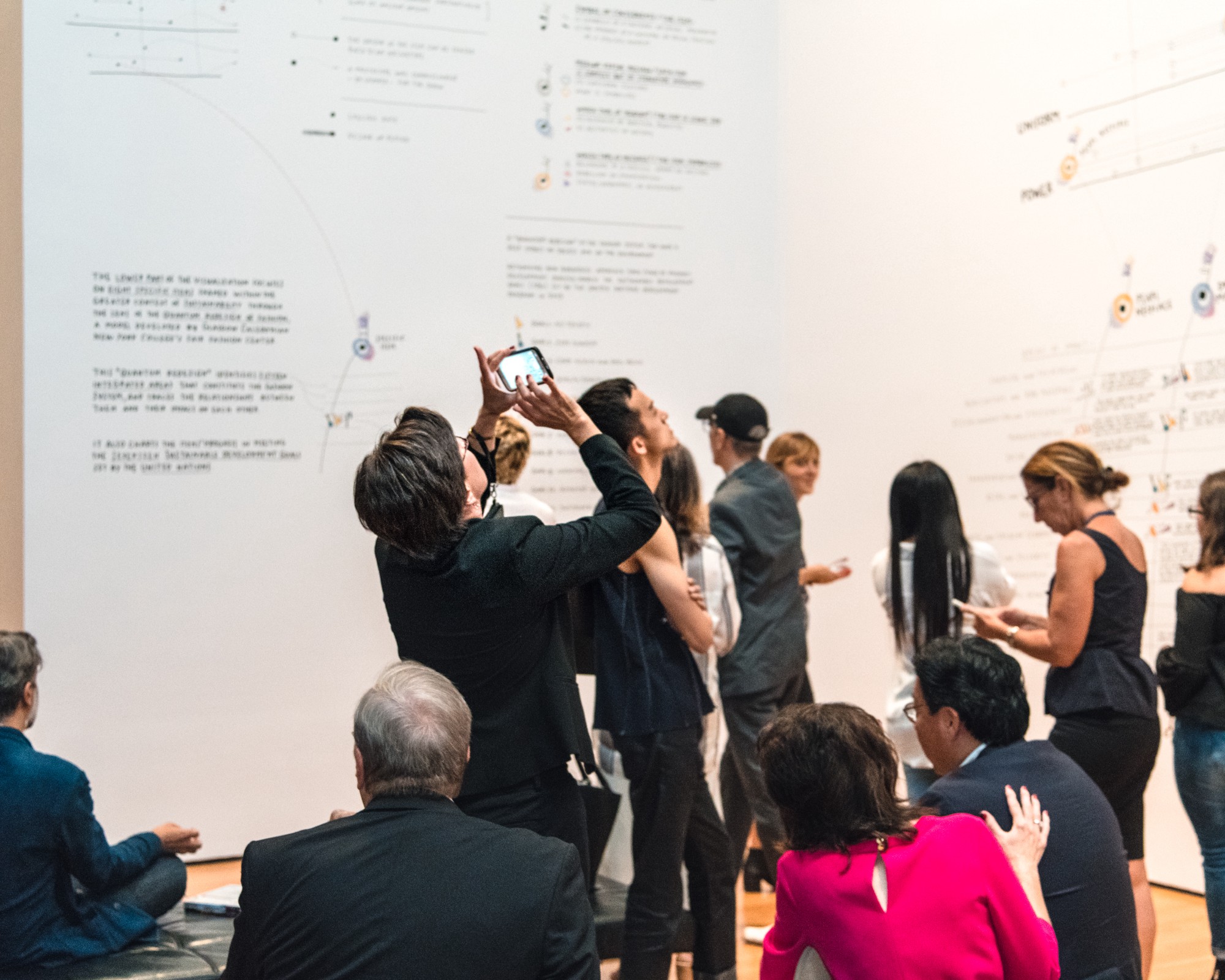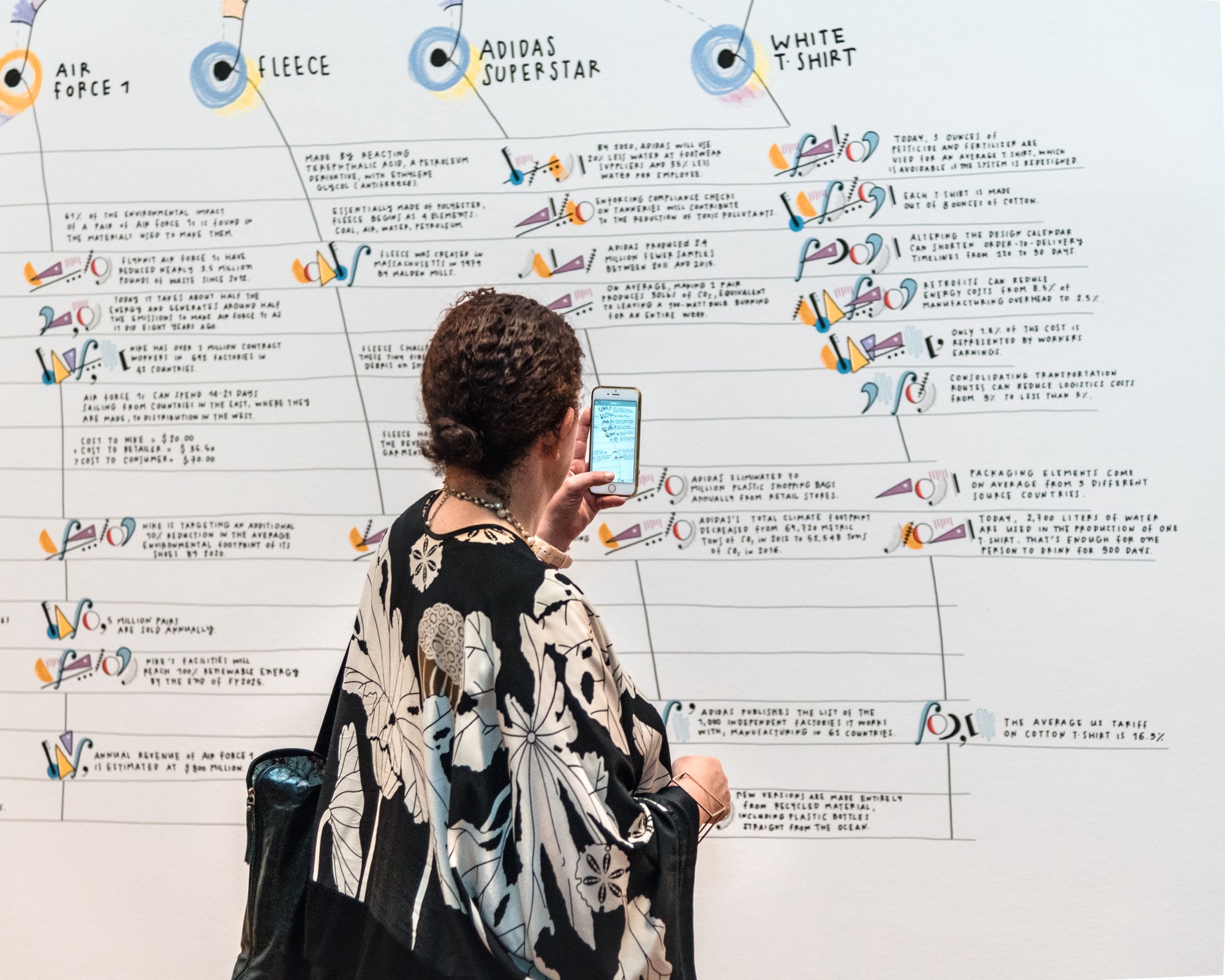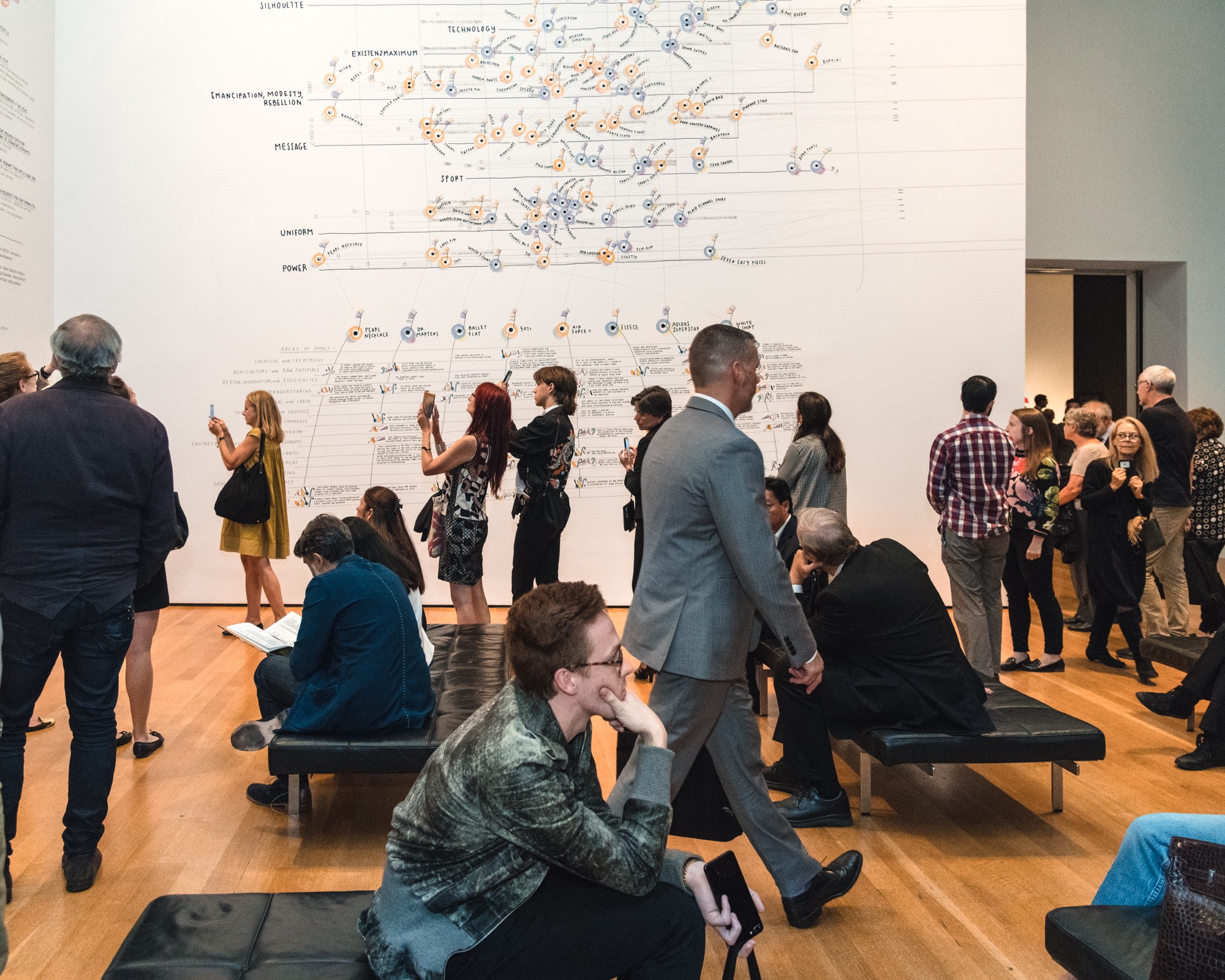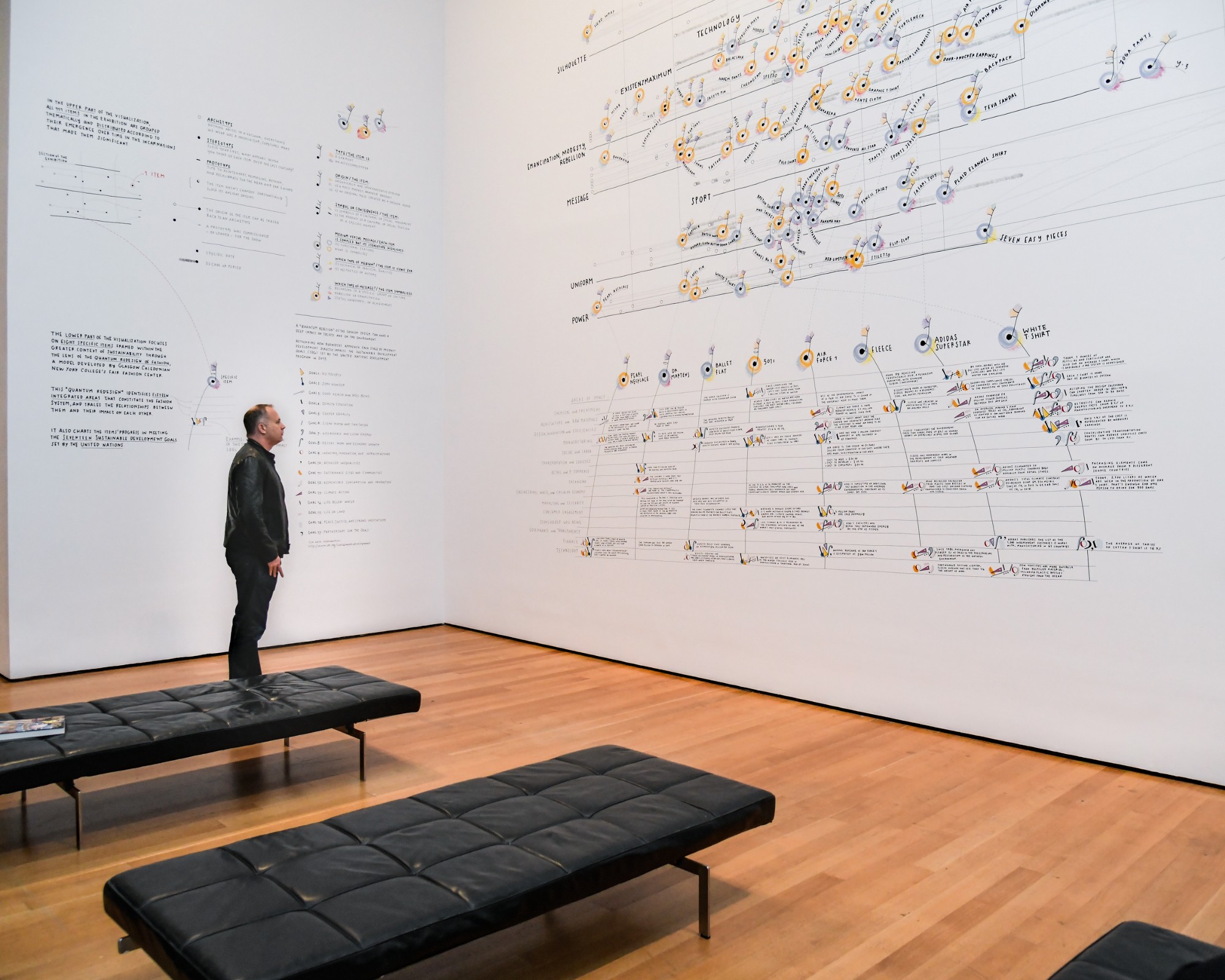Data Items: A Fashion Landscape at The Museum of Modern Art
Exploring the power and depth of soft, small and hand-crafted data
(Giorgia Lupi — Italian, born 1981 / Accurat — Italy, founded 2011. Data Items: A Fashion Landscape 2017 — Commissioned for Items: Is Fashion Modern? This project made possible by Glasgow Caledonian New York College’s Fair Fashion Center)
In the past months, I have had the huge honor of collaborating with Paola Antonelli and Michelle Millar Fisher (Senior Curator and a Curatorial Assistant in the Museum of Modern Art’s Department of Architecture and Design respectively, with Antonelli, also serving as MoMA’s Director of R&D ) and their team on a data-driven artwork that encapsulates the themes of the museum’s exhibition on fashion Items: Is Fashion Modern?
The visualization is magnificently displayed as the closing piece to the exhibition, printed at large scale over three huge twenty-foot-high walls in the sixth floor lobby towering over visitors as they stepped off the escalators.
Opening on October 1, 2017, the show explored the present, past — and sometimes the future — of 111 items of clothing and accessories that have had a strong impact on the world in the twentieth and twenty-first centuries, and continue to hold currency today. Among them are pieces as well known and transformative as Levi’s 501s, the Breton shirt, and the Little Black Dress, and as ancient and culturally charged as the sari, the pearl necklace, the kippah, and the keffiyeh.
It was a fascinating and moving exhibition; just by reading the checklist of the 111 items, it’s striking to immediately realize how prominent a role fashion plays as a connective tissue between people and cultures, and how strongly it affects how we live, think, and express ourselves in our societies and communities.
Installation photos from Items: Is Fashion Modern? at the Museum of Modern Art
For Items my team and I investigated the hidden stories of these iconic objects, digging for quantitative and qualitative information that could help us paint a picture of the fashion landscape through data, and capture the inspiration, themes, and ideas that guided the curatorial process.The result of this research and discovery process was translated into visuals in a site-specific hand-drawn visualization that explores the explicit and implicit features of the items, both individually and as part of a bigger ecosystem.
Data Items: A Fashion Landscape, 2017 — Photo by Aldo Soligno
Data Items: A Fashion Landscape, 2017 — Detail, photo from the opening
We put on the glasses of the data collector and we delved into the 111 stories in search of bits of quantitative and qualitative information that could help us answer our main questions: why was each of the items included in the show?
How could we understand and translate for the viewer the principles that guided the curatorial process by looking at this pool of unstructured and highly qualitative data?
And, ultimately, how can a visualization of this data enrich the experience for the audience?
Preliminary research process for the 111 Items included in the exhibition.
The visualization we designed, called “Data Items: A Fashion Landscape”, built around two main points of view on the collection that are articulated over different levels of information:
The Landscape depicts all of the 111 items and provides both an overview of the structure of the exhibition and a visual access to the stories and characteristics of each of the pieces exhibited.
The Capstones are eight key items we highlighted and whose stories are exploded and reconnected to their commercial lifecycle, from design, to production, to marketing, to distribution, to recycling. The Quantum Redesign of Fashion frames these Capstones within the greater context of sustainability through the lens of a sustainable development model for the industry developed by Glasgow Caledonian New York College’s Fair Fashion Center.
Data Items: A Fashion Landscape 2017 — HIGH-RESOLUTION VERSION HERE
In the first level, the Landscape, we provide a background and texture for the visual narration. This level of information reveals what we discovered about the hidden connections and patterns that guided the curatorial process and the flow of the exhibition depicting the 111 objects through their intrinsic meanings.
The 111 items are distributed on the wall according to their emergence over time in the incarnations that made them significant, and their history and origins are traced through to their archetypal form.
Working with the curatorial team, we also grouped them according to the exhibition’s interplaying narratives, and we analyzed and depicted through the use of graphic symbols the intrinsic features that make them unique and influential.
Data Items: A Fashion Landscape 2017 — Detail
The questions we tried to answer include, for example:
Is the item a medium or a message? Is it modern because of its intrinsic features and the way it was commoditized and democratized or because it bears an inherent message or statement?
Is it worn to conform or to escape? Has it become a way to blend into a social context or to break free from it?
Is it a cause or an effect? Was the item included in the show because its very existence helped to spark cultural or social change, or because it was itself the product of tension in a specific moment?
Data Items: A Fashion Landscape 2017 — Detail (The Legend)
Each item became a symbol I drew on the wall, whose visual features depend on this oddly assorted but thought-provoking set of quantitative and qualitative attributes.
Just because you don’t immediately see numbers, it doesn’t mean there is no data to identify, collect, organize, process, and analyze.
We needed to build our own dataset: we dug deep into the stories of the 111 items and into the documentation of the background research conducted by the curatorial team, and we conceived a set of questions that we used as a base to analyze each item and categorize it according to multiple overlapping criteria.
Did you know that the Dashiki is not a traditional West African garment but it is instead a mass-produced modern garment that emerged in New York City in the ‘60s? As the exhibition text highlights, “borne in 1967 out of the vision of young urban professionals Jason and Mabel Benning, shoe designer Howard Davis, and a handful of their friends who started the brand “New Breed Clothing” in Harlem, the Dashiki provided the sartorial backdrop for the natural Afros and raised fists of the Black Power movement in the 1960s and early 1970s. Benning and Davis believed their mission was “to uplift the black man by working toward economic independence and developing pride in his heritage.”
Eight of these items then become Capstones in the visualization, eight symbols we used to call attention to how fashion impacts our world at a scale that is often overlooked. Fashion is now estimated to be a $2.5 trillion industry, directly responsible for approximately 20% of the global industrial waste and of 10% of global carbon emissions. The entire lifecycle of a fashion item often involves tens of industries and sectors, from agriculture to retail, from transportation to finance; we used the stories of these very specific products to provide a glimpse of all the human lives touched by a garment or an accessory before it is worn.
Data Items: A Fashion Landscape 2017 — Detail
For these Capstone elements we created a forward-looking vision for the future that we based on the theory of the Quantum Redesign of Fashion, developed by Glasgow Caledonian New York College’s Fair Fashion Center.
Sometimes the meaningful data is in the macro and not in the micro: you just have to remember to regularly take a step back, squint your eyes to avoid getting distracted by the details, and look for the overarching structures that emerge.
The paradox of fashion is that its far-reaching tentacles have helped develop the modern world but, in doing so, have also created some of its greatest environmental and social challenges. The Quantum Redesign of Fashion theory explains that resolving these challenges requires a new perspective on the elements that form the problem. Borrowing concepts from quantum mechanics — especially the theories of entanglement and coherent resonance — and applying the ideas behind them at a different scale allows us to look at those elements as integers, and solve for a new quotient, one that encourages the industry to transform into a respectful and regenerative ecosystem. Each of the fifteen integrated businesses identified by the theory is therefore connected in the visualization to the Sustainable Development Goals that a “quantum redesign” could potentially impact, telling the story of how coordinated design-driven systemic interventions in all the steps of the lifecycle of one of the Capstones can create a dramatic impact on environment and society.
Data Items: A Fashion Landscape 2017 — Detail (The Legend)
It was an exercise in exploring and depicting the richness and depth of soft data.
Many of my most recent projects explore how we can adopt a broader definition of data, encompassing also the more subjective, intimate, personal, and therefore imperfect, aspects of the information systems that we live in.
When working with data, we so often tend to focus only on the hard numbers that are readily available to us, without realizing they can actually become much more meaningful if we are able to unearth a more nuanced and expressive type of data along with them.
Enriching hard data by combining it with an additional layer of “softer” and more qualitative information is in many situations a successful strategy to provide a much needed context that helps decode and interpret the most complex and multifaceted scenarios. And soft data, because of their shapeless nature, demand a very different approach to visual representation. To surface their true characteristics, I often take a temporary break from the conventions of data visualization — more commonly associated with formal sets of rules and good practices derived directly from a scientific and statistically-sound approach to the representation of information — and I experiment freely with visual languages and techniques, including largely using hand drawing and deliberately imprecise renderings to express the quantities I’m working with. I do this to avoid focusing the attention of the reader on the precision of the output (a very common situation with more traditional data visualization) and instead seek to drive their attention toward other more human aspects of it.
In the specific case of the original data visualization I designed for the show, I believe the hand-drawn rendition of the highly subjective and ephemeral data I was working with goes a long way to represent faithfully its nature: by no means is this a cold but perfect scientific observation of reality; it is instead a dataset built on subjective interpretation of fluid concepts such as culture, identity, inspiration, rebellion, or belonging.
Data Items: A Fashion Landscape 2017 — Detail, photo from the opening
This is what I call Data Humanism: to make data faithfully representative of our messy and intricate reality and meaningful for our complex nature as human beings, I believe we need to start designing ways to include empathy, imperfection and human qualities in how we collect, process, interpret, and display them.
